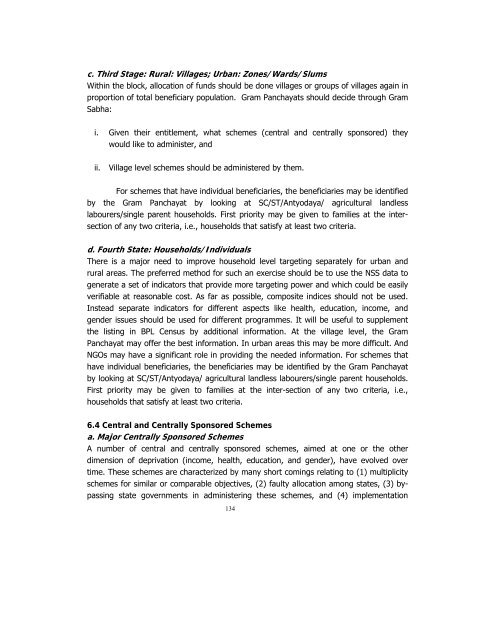POVERTY REDUCTION STRATEGY TN
Create successful ePaper yourself
Turn your PDF publications into a flip-book with our unique Google optimized e-Paper software.
c. Third Stage: Rural: Villages; Urban: Zones/Wards/Slums<br />
Within the block, allocation of funds should be done villages or groups of villages again in<br />
proportion of total beneficiary population. Gram Panchayats should decide through Gram<br />
Sabha:<br />
i. Given their entitlement, what schemes (central and centrally sponsored) they<br />
would like to administer, and<br />
ii.<br />
Village level schemes should be administered by them.<br />
For schemes that have individual beneficiaries, the beneficiaries may be identified<br />
by the Gram Panchayat by looking at SC/ST/Antyodaya/ agricultural landless<br />
labourers/single parent households. First priority may be given to families at the intersection<br />
of any two criteria, i.e., households that satisfy at least two criteria.<br />
d. Fourth State: Households/Individuals<br />
There is a major need to improve household level targeting separately for urban and<br />
rural areas. The preferred method for such an exercise should be to use the NSS data to<br />
generate a set of indicators that provide more targeting power and which could be easily<br />
verifiable at reasonable cost. As far as possible, composite indices should not be used.<br />
Instead separate indicators for different aspects like health, education, income, and<br />
gender issues should be used for different programmes. It will be useful to supplement<br />
the listing in BPL Census by additional information. At the village level, the Gram<br />
Panchayat may offer the best information. In urban areas this may be more difficult. And<br />
NGOs may have a significant role in providing the needed information. For schemes that<br />
have individual beneficiaries, the beneficiaries may be identified by the Gram Panchayat<br />
by looking at SC/ST/Antyodaya/ agricultural landless labourers/single parent households.<br />
First priority may be given to families at the inter-section of any two criteria, i.e.,<br />
households that satisfy at least two criteria.<br />
6.4 Central and Centrally Sponsored Schemes<br />
a. Major Centrally Sponsored Schemes<br />
A number of central and centrally sponsored schemes, aimed at one or the other<br />
dimension of deprivation (income, health, education, and gender), have evolved over<br />
time. These schemes are characterized by many short comings relating to (1) multiplicity<br />
schemes for similar or comparable objectives, (2) faulty allocation among states, (3) bypassing<br />
state governments in administering these schemes, and (4) implementation<br />
134

















